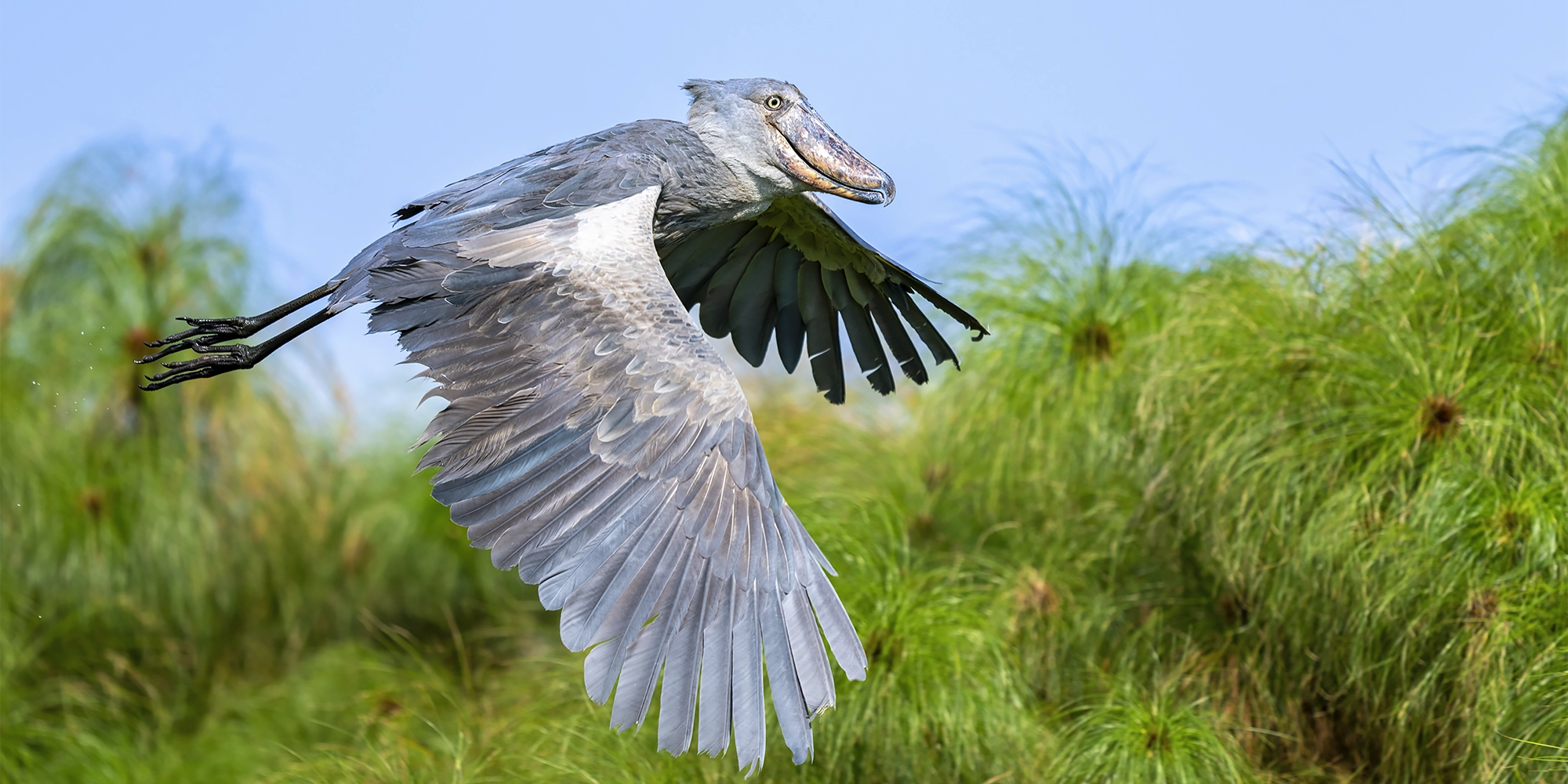5 Fascinating Facts About the Shoebill
Facts About the Shoebill
Enter the Dinosaur of the Wetlands
With its prehistoric appearance and piercing stare, the Shoebill (Balaeniceps rex) is one of Africa’s most mysterious and extraordinary birds. Standing tall and solitary in the swamps and marshes of central tropical Africa, this enigmatic avian commands attention not just because of its sheer size but due to its almost mythical aura. Known locally as the “whale-headed stork,” the Shoebill has evoked awe and curiosity among birdwatchers, researchers, and locals alike. Its massive, shoe-shaped bill and solemn demeanor give it an ancient air, as if it’s a creature suspended in time.
While many animals earn their intrigue through speed or power, the Shoebill captivates with stillness and subtle dominance. Despite being relatively elusive, this bird is gradually emerging as a symbol of the wild, untamed wetlands of East and Central Africa, most notably Uganda’s vast papyrus marshes. In this article, we unravel five compelling facts about the Shoebill, delving into what makes it one of the most fascinating creatures of the African wilderness.
A Beak Built Like a Weapon
The Shoebill’s most iconic feature is undoubtedly its massive bill, shaped eerily like a Dutch clog and reaching up to 24 centimeters long and 20 centimeters wide. More than just an oddity, this oversized beak is an evolutionary masterpiece. The edges of the bill are razor-sharp, and the powerful hook at the tip is used to grasp, crush, and decapitate prey with precision. This is not a gentle grazer—this is a bird built for stealth and lethal efficiency.
Feeding primarily on lungfish, eels, frogs, and even baby crocodiles, the Shoebill employs a hunting style that borders on theatrical. It stands perfectly still for hours, blending into its surroundings until the moment to strike arrives. With lightning speed, the Shoebill lunges forward, opening its beak wide and snapping it shut with a loud, echoing clatter that often signals a successful catch. This combination of patience and violence in hunting sets the Shoebill apart from most other wetland birds, underscoring its status as a top predator within its ecological niche.
Solitude and Strategy in the Swamps (Facts About the Shoebill)
Unlike many bird species that thrive in flocks, Shoebills are solitary hunters. They maintain and defend large territories, ensuring minimal competition for the rich aquatic resources of their marshland habitats. These territories, often several kilometers wide, are chosen with strategic precision—away from human disturbance, abundant in prey, and rich in cover.
The Shoebill’s solitary behavior extends into its mating and nesting habits. Pairs come together only briefly during the breeding season and raise a maximum of two chicks. However, in a striking example of siblicide, often only one chick survives, as the stronger nestling dominates the weaker to ensure it receives the lion’s share of food. While brutal, this behavior ensures that at least one offspring reaches maturity, especially in an environment where resources are unpredictable.
This minimalistic reproductive strategy, combined with their slow maturation, makes Shoebills particularly vulnerable to threats. Yet it also reinforces their identity as highly specialized and selective survivors, thriving only under the most optimal natural conditions.
A Call Like a Machine Gun
Despite their generally silent and stoic demeanor, Shoebills are not entirely voiceless. During the breeding season and interactions with mates or offspring, they produce a distinctive bill-clattering sound, reminiscent of a machine gun or typewriter. This sound is produced not with vocal cords but through rapid opening and closing of their formidable bills.
Chicks also emit a begging call that resembles human hiccups, a rare and almost humorous vocalization that highlights their unique auditory expressions. These sounds, although infrequent, serve as important social tools within the limited context of the Shoebill’s life.
The contrast between their quiet disposition and sudden bursts of mechanical-like sounds adds to the surreal experience of encountering one in the wild. Their eerie calls echoing across the swamp serve as a haunting reminder of their ancient lineage and otherworldly nature.
Masters of Stillness and Stealth
What truly sets the Shoebill apart behaviorally is its extraordinary stillness. Dubbed the “statue bird,” it can remain motionless for extended periods—sometimes several hours—while watching the water surface for subtle signs of movement. This monk-like patience is not lethargy; it’s a finely tuned predatory technique evolved for success in murky, vegetation-choked wetlands.
The Shoebill’s silent stalking and calculated strikes are hallmarks of its hunting prowess. Unlike herons or storks that wade and probe constantly, the Shoebill saves energy by letting prey come to it. Its entire physiology—from its long, strong legs to its forward-facing eyes—supports this precision-based strategy.
This behavior does more than help it hunt. It gives the Shoebill an almost spiritual presence, making it a favorite among wildlife photographers and birding enthusiasts. To witness this bird is to understand a different rhythm of the wild, one that values observation over action, patience over motion.
Conservation Concerns and Global Recognition
Despite their almost mythic stature, Shoebills are classified as Vulnerable by the International Union for Conservation of Nature (IUCN). Habitat loss due to agriculture, oil exploration, and settlement expansion is the bird’s most pressing threat. Additionally, the illegal pet trade has targeted Shoebills for their unusual appearance, further endangering already fragile populations.
Fortunately, global awareness and local conservation efforts are rising. Uganda, South Sudan, Zambia, and parts of the Democratic Republic of Congo are taking active roles in protecting Shoebill habitats through eco-tourism, community-based conservation, and legal protections. Bird sanctuaries and national parks are becoming safer refuges, and the Shoebill is slowly gaining the international recognition it needs to survive.
These conservation efforts also provide opportunities for travelers to witness the Shoebill responsibly. Ecotourism has emerged as one of the most powerful tools to save this bird—not only by funding protection programs but also by giving local communities a sustainable economic reason to preserve wetland environments.
Explore the Mystical World of the Shoebill with WildHorn Africa
The Shoebill is not just a bird—it’s a legend in feathers, a living relic of the past that demands both reverence and protection. Encountering this majestic bird in its natural habitat is an unforgettable experience, one that touches the soul and ignites a lifelong passion for conservation.
WildHorn Africa offers expertly guided safaris to some of the Shoebill’s last remaining strongholds, including the remote marshes of Uganda’s Mabamba Swamp. Our tours are tailored for intimate, immersive encounters with this awe-inspiring species, emphasizing ethical wildlife viewing and deep ecological appreciation.
Book your African safari with WildHorn Africa and embark on a journey that goes beyond sightseeing. Witness the haunting beauty of the Shoebill, connect with Africa’s wild heart, and become part of a movement to protect one of the continent’s most fascinating and elusive treasures. Let the wetlands whisper their ancient secrets, and let WildHorn Africa guide you to them.
Facts About the Shoebill #Facts About the Shoebill Facts About the Shoebill





 WildHorn Africa – Authentic and unforgettable tours across Africa, guided by local experts who know the land, wildlife, and culture best.
WildHorn Africa – Authentic and unforgettable tours across Africa, guided by local experts who know the land, wildlife, and culture best.


